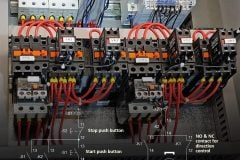DC Motor
History will recognize the vital role played by DC motors in the development of industrial power transmission systems, the dc machine being the first practical device to convert electrical power into mechanical power.
Inherently straight forward operating characteristics, flexible performance and high efficiency have encouraged the widespread use of DC motors in many types of industrial drive applications.
The basic construction of a DC motor is shown in Figure 1.

Standard DC motors are readily available in one of two main forms:
- Wound-field, where the magnetic flux in the motor is controlled by the current flowing in a field or excitation winding, usually located on the stator
- Permanent magnet, where the magnetic flux in the motor is created by permanent magnets which have a curved face to create a constant air-gap to the conventional armature, located on the rotor.
These are commonly used at powers up to approximately 3 kW. Torque in a DC motor is produced by the product of the magnetic field created by the field winding or magnets and the current flowing in the armature winding. The action of a mechanical commutator switches the armature current from one winding to another to maintain the relative position of the current to the field, thereby producing torque independent of rotor position.
Generator
Throughout the world there is a need for generators in many different applications. In addition to the underlying need for a public supply of electricity, there are a number of situations in which independent supplies are needed. The applications for generators are categorized broadly as follows:
- Public supply networks in which a number of high-power generator sets may operate in parallel
- Private or independent generators which may run in parallel with the public supply or isolated from it. Examples of this include:
.- peak shaving to reduce the maximum demand of electricity by a user; this can avoid large financial penalties during times of generally high demand on the system
- standby emergency generators to protect the supply to critical circuits such as hospitals or water supplies
- temporary supplies which are needed by the construction industry, or in cases of breakdown
- combined heat and power using the waste heat from the generator engine is used for other purposes such as building heating
- Portable supplies, often trailer-mounted, where no alternative supply is available
The two main types of generator are ‘turbo’ or cylindrical-rotor and salient-pole generators. Both these types are synchronous machines in which the rotor turns in exact synchronism with the rotating magnetic field in the stator.











Now I know more than I did before